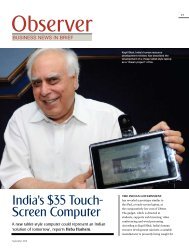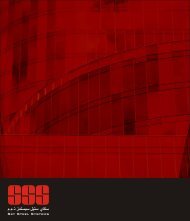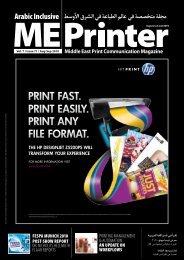Abu DhAbi ClAssiCs sCulpture symposium heritAge ... - Heba Hashem
Abu DhAbi ClAssiCs sCulpture symposium heritAge ... - Heba Hashem
Abu DhAbi ClAssiCs sCulpture symposium heritAge ... - Heba Hashem
- No tags were found...
You also want an ePaper? Increase the reach of your titles
YUMPU automatically turns print PDFs into web optimized ePapers that Google loves.
16<br />
sculpture<br />
17<br />
ArtFor the first time in the capital’s history,<br />
the <strong>Abu</strong> Dhabi International Sculpture<br />
Symposium is bringing some of the<br />
world’s top sculptors to town<br />
Billy Lee EOS, Taipei<br />
The Sculpture Symposium is more than just an exhibition.<br />
It is, in essence, a movement that arose from the Austrian<br />
town of St Margaethen in 1959 demanding more for this type of<br />
performance art. Led by Karl Prontl, members of the international<br />
sculpture community came together in a forum for communication and<br />
exchange; and <strong>Abu</strong> Dhabi’s art community has realised the value of this<br />
kind of union.<br />
“The response to the announcement of this <strong>symposium</strong> from artists around the<br />
world was overwhelming,” said Salwa Zeidan, Director of <strong>Abu</strong> Dhabi International<br />
Sculpture Symposium (ADISS) and also director of the Salwa Zeidan<br />
Gallery. There were over 400 applications, ranging from abstract<br />
ideas to semi-realistic designs, mainly aimed at complementing <strong>Abu</strong><br />
Dhabi’s culture and history.<br />
All sculpture symposia around the world are characterised by<br />
common elements. Work is usually created in public during a<br />
defined period by invited artists; sculptures are usually left with the<br />
sponsor after the event; the sculptors are paid an honorarium and<br />
hosted warmly at the country to which they have been invited.<br />
Most importantly, communities gain in stature – and<br />
become an artistic destination – by having an ongoing<br />
cultural event.<br />
Where else can a sculptor receive live feedback and<br />
continuous support from audience as he creates and forms<br />
his piece? As one sculptor, Neal Barab, puts it: “there is<br />
nothing more embarrassing as hitting your hand with a<br />
hammer as a crowd watches and nothing as satisfying as<br />
in the<br />
third<br />
dimension<br />
feeling a positive response from a public that once had<br />
thought uninterested or even hostile to art.”<br />
The extraordinary sculptures finally selected for<br />
ADISS have been created by 17 contemporary artists,<br />
each piece concealing a story and representing<br />
potential depths and meanings. Although cutting edge<br />
technology and pneumatic tools today have changed<br />
the techniques and the pace of working in stone, some<br />
primary methods cannot be replaced; it remains an<br />
arduous form of art that involves great physical effort.<br />
“The aim here is to have ADISS take on the<br />
form of a performing art event, an open sculpture<br />
studio involving participation of both artists and the<br />
public,” explains Zeidan. “People will be able to<br />
(L-R) Salah Khider, Abeer Al Mutawa, Dr. Sulaiman Al Jassim, Salwa Zeidan<br />
observe the evolution of a sculpture as it goes from<br />
conceptualisation through planning, carving, roughing,<br />
smoothing and polishing.” Artists will indeed be<br />
creating their sculptures live every day (except Friday)<br />
throughout the two weeks of the event.<br />
Fostering new sculpting talents is one of ADISS’s top<br />
priorities. Having found 16 artists of the highest calibre<br />
on the international stage, the organisers ensured that<br />
one emerging artist with a promising talent was also<br />
given a chance. For 2010 ADISS has selected Husam<br />
Chaya from Lebanon, and the plan is to introduce a<br />
new artist every year.<br />
Encouragement for new talent also extends to art<br />
students, who are getting major attention as part of this<br />
initiative. “The lecture series include several workshops<br />
and presentations to Zayed University students,<br />
especially those enrolled in the art programs at the<br />
<strong>Abu</strong> Dhabi and Dubai campuses as well as four public<br />
lectures that will be open to anyone is interested in the<br />
topics covered,” says Salwa Zeidan.<br />
All of the lectures will be held by the participating<br />
artists on the grounds of Zayed University in both the<br />
<strong>Abu</strong> Dhabi and Dubai campuses. Seven will be limited<br />
to Zayed University staff and students, four additional<br />
lectures will be open to the public – including a Public<br />
Panel with Hassan Sharif, Caroline Ramersdorfer, Ehab<br />
El-Laban and Jon Barlow Hudson.<br />
The first of the public lectures will debate public art,<br />
its history and how it fits into <strong>Abu</strong> Dhabi. The second,<br />
“Art in the Urban scene”, has Juanjo Novella reviewing<br />
art as an agent for regeneration of public space. The<br />
third session by Konstantine Dimpoulos is titled “Art<br />
saving the World” and the fourth will discuss Art and<br />
the Environment.<br />
The Sculpture Symposium is undoubtedly a<br />
sculptor’s fantasy come true, and it is an idea that<br />
the art-loving community of <strong>Abu</strong> Dhabi has been<br />
long contemplating. “We have been developing this<br />
idea over the past two years,” declared Zeidan. “I am<br />
proud to work with this wonderful team that is equally<br />
excited about making it history!”<br />
The <strong>Abu</strong> Dhabi International Sculpture Symposium<br />
is held at the Armed Forces Officers Club, from<br />
February 25 until April 7. Visiting hours are 5pm to<br />
7pm, Saturday to Thursday. Entry is free. For details on<br />
the public lecture programmes and workshops, visit<br />
www.adiss-ae.com<br />
Gregor Kregar- Brick Bay Polyhedron, 2007,<br />
549x366x366cm, stainless steel,<br />
Bick Bay Sculpture Park, matakana, NZ<br />
Meet the artist<br />
Billy Lee<br />
Born of Chinese and Dutch<br />
parentage, South African Billy<br />
Lee graduated from Birmingham<br />
College of Arts and received<br />
his MFA at the Royal College of<br />
Art in London. On graduation<br />
he received a prestigious<br />
Kennedy Scholarship (and he remains the only artist<br />
ever to receive one). His maquettes symbolise human<br />
expression and simplicity can be felt in his granite,<br />
stone, steel and bronze-made<br />
monumental masterpieces.<br />
Caroline Ramersdorfer<br />
Austrian Caroline Ramersdorfer<br />
studied philosophy in Paris in<br />
1979, and went on to African<br />
art history, museum science and<br />
analysis of Renaissance frescoes<br />
and their restoration at the International University<br />
of Art in Florence. Ramersdorfer finds her joy when<br />
carving fragments from blocks of stones or marbles and<br />
repositioning them.<br />
Piece by Juanjo Novella<br />
Ehab El Laban<br />
Born in Cairo in 1976, Ehab<br />
El-Laban obtained a degree in<br />
Art Education in 2000. He leads<br />
a dual career as a creator and<br />
as a cultural operator. El-Laban’s<br />
achievements earned him the<br />
Jury prize in the 13th Youth<br />
Salon, the Grand Prix in the 14th edition and the Top<br />
Prize in the 15th Edition of the same Competition.<br />
Fabrizio Dieci<br />
Dieci holds a Masters Degree from the Academy of<br />
Carrera, Italy. He has been exhibiting throughout<br />
Europe, the Middle and Far East since 1998, and has<br />
been regularly participating in major International<br />
Symposia since 1993.<br />
Gheorghi Filin<br />
Gheorghi Filin from Bulgaria has been referred to as a<br />
“sculptor of liberated free forms”. Filin was educated<br />
first at the artistic Academy of Sofia, then at the<br />
Academy of Fine Arts where he became a teacher;<br />
for more than ten years he held the post of Professor<br />
of Sculpture at the Academy. Filin believes in getting<br />
March 2010<br />
March 2010






